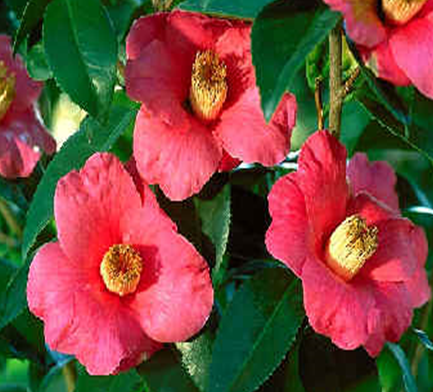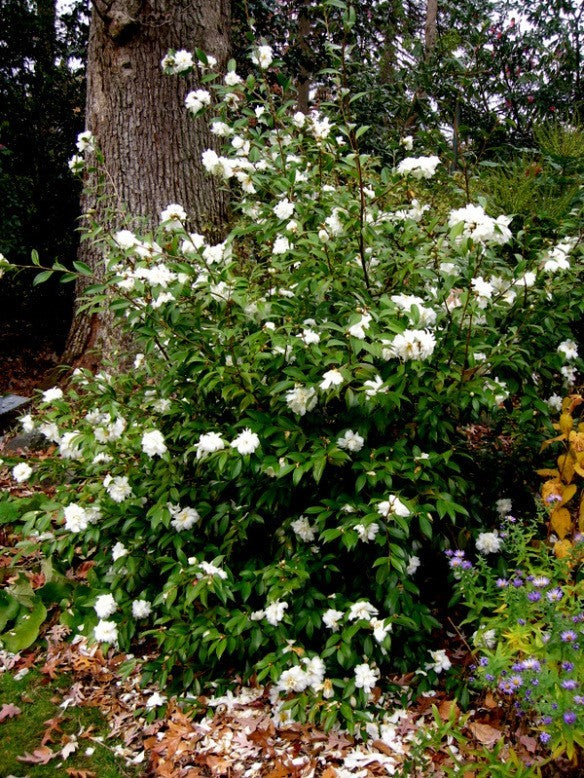by Ken Lain, the mountain gardener

Vivid rose-colored blossoms reach 2-3 inches wide with petals radiating out from a center of contrasting golden stamens. Ice Angle Camellia deserves front yard stature or admired on a patio or deck. Brings glossy foliage and elegance under dull shade trees. Well adapted to the acidic soils beneath oaks, native junipers, and maples. Grows 4’x4′ and loves shade gardens, containers, and raised beds.
The graceful waxen flowers of camellia are a symbol of easy elegance. Alabama has even chosen it for their state flower. Camellias have a reputation for being somewhat tricky to grow, but if you’re willing to meet their needs, they’ll reward you with a long bloom season just when you need it most in the early spring gardens.
History
Camellias are native to Southeast Asia. They’re part of a large genus, Camellia, whose most famous member is used in tea worldwide. Camellia sinensis flowers may be insignificant, but the leaves are grown and harvested to make teas of all kinds.
The beloved flowering varieties are more common in gardens. Camellia japonica is the only mountain variety willing to grow at colder elevations.
Botanical Name Camellia japonica
Common Name Camellia
Plant Type Evergreen Shrub
Mature Size 6’x5′ feet
Sun Exposure under 6 hours sun to part shade
Soil Type Moist, well-drained
Soil pH Slightly acidic 5.5-7.5
Bloom Time Spring
Flower Color Red, pink to white
Hardiness Zones 6 to 10
Native Area Southeast Asia
Light
Camellias need protection from the hot afternoon sun. Morning sun and dappled afternoon shade is the ideal garden spot. As the plants grow, their foliage protects roots from damaging sun.
Soil
Camellias like to grow in well-drained, slightly acidic soil. The ideal soil pH range of 5.5 to 6.5; high pH stresses the plant with yellow foliage. Feed regularly with Watters 7-4-4 All Purpose Food to correct your soil’s pH. Camellia grows well in containers with a rich blend of Watters Potting Soil that efficiently controls the soil pH.
It’s vital to ensure the area you choose has well-drained soil. Avoid spots in your garden that are regularly soggy. If in doubt, dig a 12″x12″ hole and fill it with water. If it drains in 15 minutes or so, your soil is fast-draining and should work well for these flowering beauties.
Water newly planted trees regularly with a garden hose for at least one month (2 months in Summer). Automatic irrigation systems may not be sufficient initially. Water frequency will vary according to the season, exposure, and plant size.
April – Oct this Shrub should be irrigated 2 x weekly
Nov – Mar this Shrub should be irrigated 2 x monthly
Feed 4x Times per Year with either 7-4-4 All Purpose Plant Food, Soil Sulfur, or Humic. Here’s the recommendation by season:
Spring = 7-4-4 All Purpose Food + Soil Sulfur
Summer = 7-4-4 All Purpose Food + Humic
September = 7-4-4 All Purpose Food
December = 7-4-4 All Purpose Food

Camellias are a little pickier than most plants. If they’re planted too deep or mulched too heavy, the stems rot. Dig the planting hole the same depth as the root ball, then add a few inches of soil back into the hole to slightly decrease the depth. When you set the plant into the hole, the top of the root ball should be slightly above the surrounding dirt level. Fill in the gap, sloping the fill dirt up to the top of the root ball without covering it. Mulch lightly, no more than an inch.
Pruning
Prune just after their bloom season ends; simply prune when the flowers are done.

